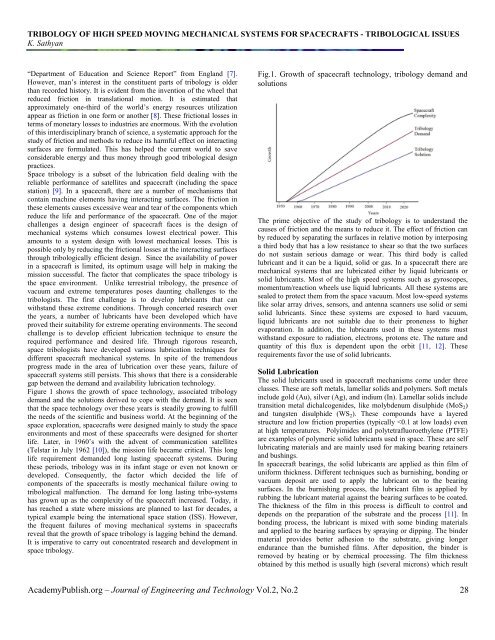Download complete journal in PDF form - Academy Publish
Download complete journal in PDF form - Academy Publish
Download complete journal in PDF form - Academy Publish
You also want an ePaper? Increase the reach of your titles
YUMPU automatically turns print PDFs into web optimized ePapers that Google loves.
TRIBOLOGY OF HIGH SPEED MOVING MECHANICAL SYSTEMS FOR SPACECRAFTS - TRIBOLOGICAL ISSUES<br />
K. Sathyan<br />
“Department of Education and Science Report” from England [7].<br />
However, man’s <strong>in</strong>terest <strong>in</strong> the constituent parts of tribology is older<br />
than recorded history. It is evident from the <strong>in</strong>vention of the wheel that<br />
reduced friction <strong>in</strong> translational motion. It is estimated that<br />
approximately one-third of the world’s energy resources utilization<br />
appear as friction <strong>in</strong> one <strong>form</strong> or another [8]. These frictional losses <strong>in</strong><br />
terms of monetary losses to <strong>in</strong>dustries are enormous. With the evolution<br />
of this <strong>in</strong>terdiscipl<strong>in</strong>ary branch of science, a systematic approach for the<br />
study of friction and methods to reduce its harmful effect on <strong>in</strong>teract<strong>in</strong>g<br />
surfaces are <strong>form</strong>ulated. This has helped the current world to save<br />
considerable energy and thus money through good tribological design<br />
practices.<br />
Space tribology is a subset of the lubrication field deal<strong>in</strong>g with the<br />
reliable per<strong>form</strong>ance of satellites and spacecraft (<strong>in</strong>clud<strong>in</strong>g the space<br />
station) [9]. In a spacecraft, there are a number of mechanisms that<br />
conta<strong>in</strong> mach<strong>in</strong>e elements hav<strong>in</strong>g <strong>in</strong>teract<strong>in</strong>g surfaces. The friction <strong>in</strong><br />
these elements causes excessive wear and tear of the components which<br />
reduce the life and per<strong>form</strong>ance of the spacecraft. One of the major<br />
challenges a design eng<strong>in</strong>eer of spacecraft faces is the design of<br />
mechanical systems which consumes lowest electrical power. This<br />
amounts to a system design with lowest mechanical losses. This is<br />
possible only by reduc<strong>in</strong>g the frictional losses at the <strong>in</strong>teract<strong>in</strong>g surfaces<br />
through tribologically efficient design. S<strong>in</strong>ce the availability of power<br />
<strong>in</strong> a spacecraft is limited, its optimum usage will help <strong>in</strong> mak<strong>in</strong>g the<br />
mission successful. The factor that complicates the space tribology is<br />
the space environment. Unlike terrestrial tribology, the presence of<br />
vacuum and extreme temperatures poses daunt<strong>in</strong>g challenges to the<br />
tribologists. The first challenge is to develop lubricants that can<br />
withstand these extreme conditions. Through concerted research over<br />
the years, a number of lubricants have been developed which have<br />
proved their suitability for extreme operat<strong>in</strong>g environments. The second<br />
challenge is to develop efficient lubrication technique to ensure the<br />
required per<strong>form</strong>ance and desired life. Through rigorous research,<br />
space tribologists have developed various lubrication techniques for<br />
different spacecraft mechanical systems. In spite of the tremendous<br />
progress made <strong>in</strong> the area of lubrication over these years, failure of<br />
spacecraft systems still persists. This shows that there is a considerable<br />
gap between the demand and availability lubrication technology.<br />
Figure 1 shows the growth of space technology, associated tribology<br />
demand and the solutions derived to cope with the demand. It is seen<br />
that the space technology over these years is steadily grow<strong>in</strong>g to fulfill<br />
the needs of the scientific and bus<strong>in</strong>ess world. At the beg<strong>in</strong>n<strong>in</strong>g of the<br />
space exploration, spacecrafts were designed ma<strong>in</strong>ly to study the space<br />
environments and most of these spacecrafts were designed for shorter<br />
life. Later, <strong>in</strong> 1960’s with the advent of communication satellites<br />
(Telstar <strong>in</strong> July 1962 [10]), the mission life became critical. This long<br />
life requirement demanded long last<strong>in</strong>g spacecraft systems. Dur<strong>in</strong>g<br />
these periods, tribology was <strong>in</strong> its <strong>in</strong>fant stage or even not known or<br />
developed. Consequently, the factor which decided the life of<br />
components of the spacecrafts is mostly mechanical failure ow<strong>in</strong>g to<br />
tribological malfunction. The demand for long last<strong>in</strong>g tribo-systems<br />
has grown up as the complexity of the spacecraft <strong>in</strong>creased. Today, it<br />
has reached a state where missions are planned to last for decades, a<br />
typical example be<strong>in</strong>g the <strong>in</strong>ternational space station (ISS). However,<br />
the frequent failures of mov<strong>in</strong>g mechanical systems <strong>in</strong> spacecrafts<br />
reveal that the growth of space tribology is lagg<strong>in</strong>g beh<strong>in</strong>d the demand.<br />
It is imperative to carry out concentrated research and development <strong>in</strong><br />
space tribology.<br />
Fig.1. Growth of spacecraft technology, tribology demand and<br />
solutions<br />
The prime objective of the study of tribology is to understand the<br />
causes of friction and the means to reduce it. The effect of friction can<br />
by reduced by separat<strong>in</strong>g the surfaces <strong>in</strong> relative motion by <strong>in</strong>terpos<strong>in</strong>g<br />
a third body that has a low resistance to shear so that the two surfaces<br />
do not susta<strong>in</strong> serious damage or wear. This third body is called<br />
lubricant and it can be a liquid, solid or gas. In a spacecraft there are<br />
mechanical systems that are lubricated either by liquid lubricants or<br />
solid lubricants. Most of the high speed systems such as gyroscopes,<br />
momentum/reaction wheels use liquid lubricants. All these systems are<br />
sealed to protect them from the space vacuum. Most low-speed systems<br />
like solar array drives, sensors, and antenna scanners use solid or semi<br />
solid lubricants. S<strong>in</strong>ce these systems are exposed to hard vacuum,<br />
liquid lubricants are not suitable due to their proneness to higher<br />
evaporation. In addition, the lubricants used <strong>in</strong> these systems must<br />
withstand exposure to radiation, electrons, protons etc. The nature and<br />
quantity of this flux is dependent upon the orbit [11, 12]. These<br />
requirements favor the use of solid lubricants.<br />
Solid Lubrication<br />
The solid lubricants used <strong>in</strong> spacecraft mechanisms come under three<br />
classes. These are soft metals, lamellar solids and polymers. Soft metals<br />
<strong>in</strong>clude gold (Au), silver (Ag), and <strong>in</strong>dium (In). Lamellar solids <strong>in</strong>clude<br />
transition metal dichalcogenides, like molybdenum disulphide (MoS 2 )<br />
and tungsten disulphide (WS 2 ). These compounds have a layered<br />
structure and low friction properties (typically












